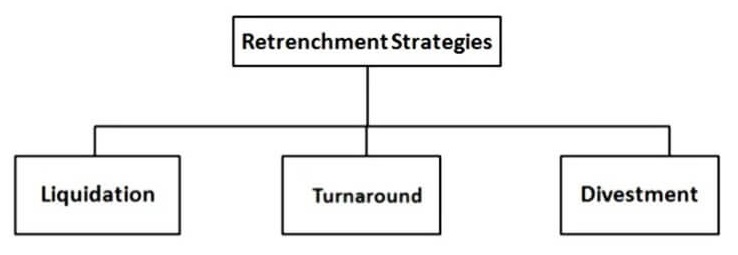Definition: A retrenchment strategy helps an organization reduce its operations or cut expenses to achieve a financially stable position.
Businesses adopt retrenchment strategies due to economic downfall, losses, or legal issues. A retrenchment strategy can be used to downsize or restructure the business.
Types of Retrenchment Strategies

- Liquidation
- Turnaround
- Divestment
Liquidation
An organization sells off its assets or closes a business unit in liquidation. Liquidation is the worst form of retrenchment strategy and causes loss of business, opportunity, employment, and brand recognition.
Businesses opt for this strategy due to continuous loss, unstable political conditions, corporate conflicts, poor management, and other factors.
Turnaround
Turnaround is retreating from previously incorrect decisions and turning a loss-making business unit into a profitable one.
Businesses often ignore some operations or units, causing them to sink into losses. However, they go for a turnaround retrenchment strategy to bring the loss-making unit back on track when they realize their mistakes.
Divestment
In divestment, the organization downsizes its operations or sells a business unit to focus on its core issues and uses the money to grow its core business.
Note that divestment is different from liquidation. In liquidation, an organization sells its unit and closes the door, while in divestment, they sell a non-strategic business and get money for strategic investment in their core business.
Examples of Retrenchment Strategy
- A hotel chain is facing losses in the restaurant business, so they sell it off and focus on hoteling, and start outsourcing the food and beverage services. This is an example of a liquidation strategy.
- After sacking Steve Jobs from Apple in 1985, Apple started losing its market position. However, his return in 1997 turned the company around, and now it is the largest tech company on the planet. This is an example of a turnaround retrenchment strategy.
- An organization had three separate business operations. The return on investment was 20%, 15%, and 5%. So, they decided to sell the third operation and use the money to grow the first business. This is an example of a divestment retrenchment strategy.
Summary
Retrenchment strategies can be used to stop an organization from going bankrupt and grow the business. Liquidation strategy helps organizations cut costs, while divestment and turnaround help them grow their operations.
